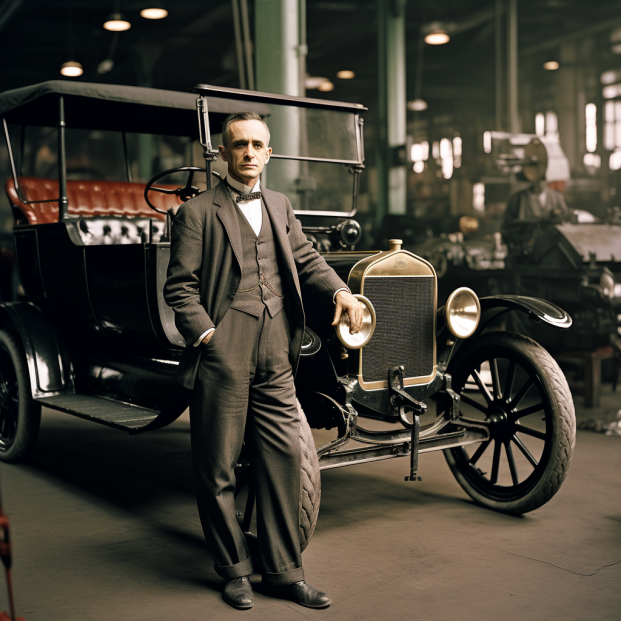Henry Ford and the Model T: Mobilising the masses

Imagine a world where automobiles were a luxury only the affluent could afford.
Henry Ford irrevocably altered this narrative with the introduction and subsequent mass production of the Model T, a car that was affordable, reliable, and, crucially, accessible to the average American.
Importantly, beyond America, he made the Model T the first truly global car.
Here are the facts:
The year is 1908. It’s Detroit, Michigan.
Automobiles had been produced since the 1880s but they were very much still a curio or a hobby for the super-rich of the day.
Henry Ford and his team of engineers introduced the Model T with the aspiration of making automobile ownership possible for the average individual.
The car was designed to be sturdy and simple, making it reliable and easy to repair.
Ford embraced and further developed the moving assembly line, facilitating the mass production of the Model T, which not only drastically reduced production costs but also enabled the price of the Model T to be lowered over time, making it increasingly accessible to a wider demographic.
Key Outcomes:
- The Model T became the first automobile accessible to the masses.
- Mass production enabled the price of the Model T to drop from $850 to as low as $260.
- The vehicle's simplicity and reliability became a benchmark in the automotive industry.
- The adoption of automobiles influenced societal structures, including urban planning, travel, and the economy.
What can we learn from this as leaders?
1. Vision Translated into Innovation:
- Ford's vision of making automobiles accessible to the masses was brilliantly translated into the creation and mass production of the Model T.
- We know from his biography that he famously said that customers can have any colour they want, as long as it was black.
- Ford’s technique was to provide the standard. The customer could customise.
- All of this demonstrates how clear, visionary goals can drive innovation and product development.
2. Embracing and Enhancing Technology:
- The deployment and refinement of the moving assembly line exhibit how embracing and enhancing existing technologies can revolutionize production processes and market accessibility.
- Ford made the market with Model T and he made the entire system to cater for the market he created.
3. Pricing as a Tool for Market Expansion:
- Ford’s strategy of continually lowering the price of the Model T illustrates how pricing strategies can be effectively utilized to expand market reach and facilitate product adoption across different demographics.
- Tesla Motors are doing the same today with their electric cars. Taking the exact same playbook from Ford, they are bringing their prices down as they build out their infrastructure.
4. Impact Beyond the Product:
- The wide adoption of the Model T altered various societal and economic structures, spotlighting how products can transcend their immediate utility and embed themselves into societal norms and structures.
- With the mass adoption of automobiles, the city planners had to design cities, there had to be gas stations, and there were new businesses created that catered to fixing or customising the Fords.
- Ford’s vision grew his own business and that of plenty of other seemingly unconnected people.
5. Customer-Centric Product Development:
- The Model T was designed with the average consumer in mind, showcasing the importance of developing products that align with the needs and capabilities of the target market.
- Ford knew the way to build a business was not to cater just for the super-rich who could afford the new automobiles. He had to dream bigger and pinpoint what pain-points an automobile would solve for the average worker.
Concluding Thoughts
Henry Ford’s Model T and its allied mass production technique symbolize a watershed moment in industrial history, intertwining technological innovation with societal and economic transformation.
Ford demonstrated how a clear vision, aligned with strategic innovation and customer-centric product development, can radically reshape markets and societal structures alike.
The Model T did not merely represent an affordable vehicle; it symbolized mobility, freedom, and an enhanced lifestyle for the average person.
This underlines the profound, rippling impacts that innovative products, paired with strategic market approaches, can propagate within and beyond industry boundaries.
Your Reflection
As you reflect upon Henry Ford’s ingenuity and leadership through the journey of the Model T, consider:
- How can your visionary goals be translated into product or service innovations?
- In what ways can you leverage or enhance existing technologies to revolutionize your offerings and production processes?
- How might your products or services reshape or create new market landscapes and societal structures?
- Can pricing and production strategies be refined to expand your market reach and influence?
Henry Ford’s Model T invites us to explore the fascinating intersections of innovation, market strategy, and societal impact, offering timeless lessons for leaders, innovators, and strategists across generations.



